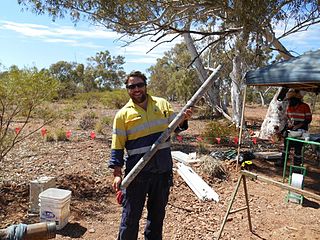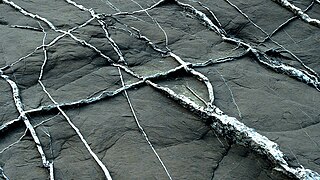
An earthquake – also called a quake, tremor, or temblor – is the shaking of the Earth's surface resulting from a sudden release of energy in the lithosphere that creates seismic waves. Earthquakes can range in intensity, from those so weak they cannot be felt, to those violent enough to propel objects and people into the air, damage critical infrastructure, and wreak destruction across entire cities. The seismic activity of an area is the frequency, type, and size of earthquakes experienced over a particular time. The seismicity at a particular location in the Earth is the average rate of seismic energy release per unit volume.

Mining is the extraction of valuable geological materials and minerals from the surface of the Earth. Mining is required to obtain most materials that cannot be grown through agricultural processes, or feasibly created artificially in a laboratory or factory. Ores recovered by mining include metals, coal, oil shale, gemstones, limestone, chalk, dimension stone, rock salt, potash, gravel, and clay. The ore must be a rock or mineral that contains valuable constituent, can be extracted or mined and sold for profit. Mining in a wider sense includes extraction of any non-renewable resource such as petroleum, natural gas, or even water.

Structural geology is the study of the three-dimensional distribution of rock units with respect to their deformational histories. The primary goal of structural geology is to use measurements of present-day rock geometries to uncover information about the history of deformation (strain) in the rocks, and ultimately, to understand the stress field that resulted in the observed strain and geometries. This understanding of the dynamics of the stress field can be linked to important events in the geologic past; a common goal is to understand the structural evolution of a particular area with respect to regionally widespread patterns of rock deformation due to plate tectonics.

Underground hard-rock mining refers to various underground mining techniques used to excavate "hard" minerals, usually those containing metals, such as ore containing gold, silver, iron, copper, zinc, nickel, tin, and lead. It also involves the same techniques used to excavate ores of gems, such as diamonds and rubies. Soft-rock mining refers to the excavation of softer minerals, such as salt, coal, and oil sands.

In geology, a fault is a planar fracture or discontinuity in a volume of rock across which there has been significant displacement as a result of rock-mass movements. Large faults within Earth's crust result from the action of plate tectonic forces, with the largest forming the boundaries between the plates, such as the megathrust faults of subduction zones or transform faults. Energy release associated with rapid movement on active faults is the cause of most earthquakes. Faults may also displace slowly, by aseismic creep.

Engineering geology is the application of geology to engineering study for the purpose of assuring that the geological factors regarding the location, design, construction, operation and maintenance of engineering works are recognized and accounted for. Engineering geologists provide geological and geotechnical recommendations, analysis, and design associated with human development and various types of structures. The realm of the engineering geologist is essentially in the area of earth-structure interactions, or investigation of how the earth or earth processes impact human made structures and human activities.
Induced seismicity is typically earthquakes and tremors that are caused by human activity that alters the stresses and strains on Earth's crust. Most induced seismicity is of a low magnitude. A few sites regularly have larger quakes, such as The Geysers geothermal plant in California which averaged two M4 events and 15 M3 events every year from 2004 to 2009. The Human-Induced Earthquake Database (HiQuake) documents all reported cases of induced seismicity proposed on scientific grounds and is the most complete compilation of its kind.
An interplate earthquake is an earthquake that occurs at the boundary between two tectonic plates. Earthquakes of this type account for more than 90 percent of the total seismic energy released around the world. If one plate is trying to move past the other, they will be locked until sufficient stress builds up to cause the plates to slip relative to each other. The slipping process creates an earthquake with relative displacement on either side of the fault, resulting in seismic waves which travel through the Earth and along the Earth's surface. Relative plate motion can be lateral as along a transform fault boundary, vertical if along a convergent boundary or a divergent boundary, and oblique, with horizontal and lateral components at the boundary. Interplate earthquakes associated at a subduction boundary are called megathrust earthquakes, which include most of the Earth's largest earthquakes.

In geology, a vein is a distinct sheetlike body of crystallized minerals within a rock. Veins form when mineral constituents carried by an aqueous solution within the rock mass are deposited through precipitation. The hydraulic flow involved is usually due to hydrothermal circulation.
U.S. Silver & Gold Inc. was a mining company based in Wallace, Idaho near Coeur d'Alene, Idaho. The chairman of the company was Bobby E. Cooper, the CEO was Tom Parker.

A fracture is any separation in a geologic formation, such as a joint or a fault that divides the rock into two or more pieces. A fracture will sometimes form a deep fissure or crevice in the rock. Fractures are commonly caused by stress exceeding the rock strength, causing the rock to lose cohesion along its weakest plane. Fractures can provide permeability for fluid movement, such as water or hydrocarbons. Highly fractured rocks can make good aquifers or hydrocarbon reservoirs, since they may possess both significant permeability and fracture porosity.

}} Geodynamics is a subfield of geophysics dealing with dynamics of the Earth. It applies physics, chemistry and mathematics to the understanding of how mantle convection leads to plate tectonics and geologic phenomena such as seafloor spreading, mountain building, volcanoes, earthquakes, faulting. It also attempts to probe the internal activity by measuring magnetic fields, gravity, and seismic waves, as well as the mineralogy of rocks and their isotopic composition. Methods of geodynamics are also applied to exploration of other planets.

Odin Mine is a disused lead mine in the Peak District National Park, situated at grid reference SK133835. It lies on a site of 25 hectares near the village of Castleton, England. It is the oldest documented mine in Derbyshire and is thought to be one of the oldest lead mines in England. The mine is a Scheduled Ancient Monument and has biological and geological significance within the Castleton Site of Special Scientific Interest.
Room and pillar or pillar and stall is a variant of breast stoping. It is a mining system in which the mined material is extracted across a horizontal plane, creating horizontal arrays of rooms and pillars. To do this, "rooms" of ore are dug out while "pillars" of untouched material are left to support the roof – overburden. Calculating the size, shape, and position of pillars is a complicated procedure, and is an area of active research. The technique is usually used for relatively flat-lying deposits, such as those that follow a particular stratum. Room and pillar mining can be advantageous because it reduces the risk of surface subsidence compared to other underground mining techniques. It is also advantageous because it can be mechanized, and is relatively simple. However, because significant portions of ore may have to be left behind, recovery and profits can be low. Room and pillar mining was one of the earliest methods used, although with significantly more man-power.

Creighton Mine is an underground nickel, copper, and platinum-group elements (PGE) mine. It is presently owned and operated by Vale Limited in the city of Greater Sudbury, Ontario, Canada. Open pit mining began in 1901, and underground mining began in 1906. The mine is situated in the Sudbury Igneous Complex (SIC) in its South Range geologic unit. The mine is the source of many excavation-related seismic events, such as earthquakes and rock burst events. It is home to SNOLAB, and is currently the deepest nickel mine in Canada. Expansion projects to deepen the Creighton Mine are currently underway.
An outburst is the sudden and violent ejection of coal, rock, and gas from a coal face and surrounding strata in an underground coal mine. Outbursts can be a very serious events, possibly even resulting in fatalities.

Mponeng is a gold mine in South Africa's Gauteng province. It is an ultra-deep tabular mine of the Witwatersrand Basin. Previously known as Western Deep Levels #1 Shaft, the underground and surface works were commissioned in 1986. It extends over 4 kilometres (2.5 mi) below the surface, and is considered to be one of the most substantial gold mines in the world. It is also currently the world's deepest mine from ground level, reaching a depth of 4 km below ground level, with aims to deepen the mine to reach additional reserves. The trip from the surface to the bottom of the mine takes over an hour. Mining in South Africa has had a huge effect on the technologies of deep gold mining around the world, South Africa is even considered a pioneer of the trade.

The environmental impact of Iron ore mining in all its phases from excavation to beneficiation to transportation may have detrimental effects on air quality, water quality, and biological species. This is predominantly a result of large-scale iron ore tailings that are released into the environment which are harmful to both animals and humans.
With the development of both conventional and unconventional resources in Canada, induced seismicity caused by anthropological activities has been observed, documented, and studied.
R. Paul Young, FREng, FRSC, is a geophysicist and Professor who works in rock mechanics using induced seismicity to monitor fractures and rock damage for engineering applications in mining and radioactive waste management.













